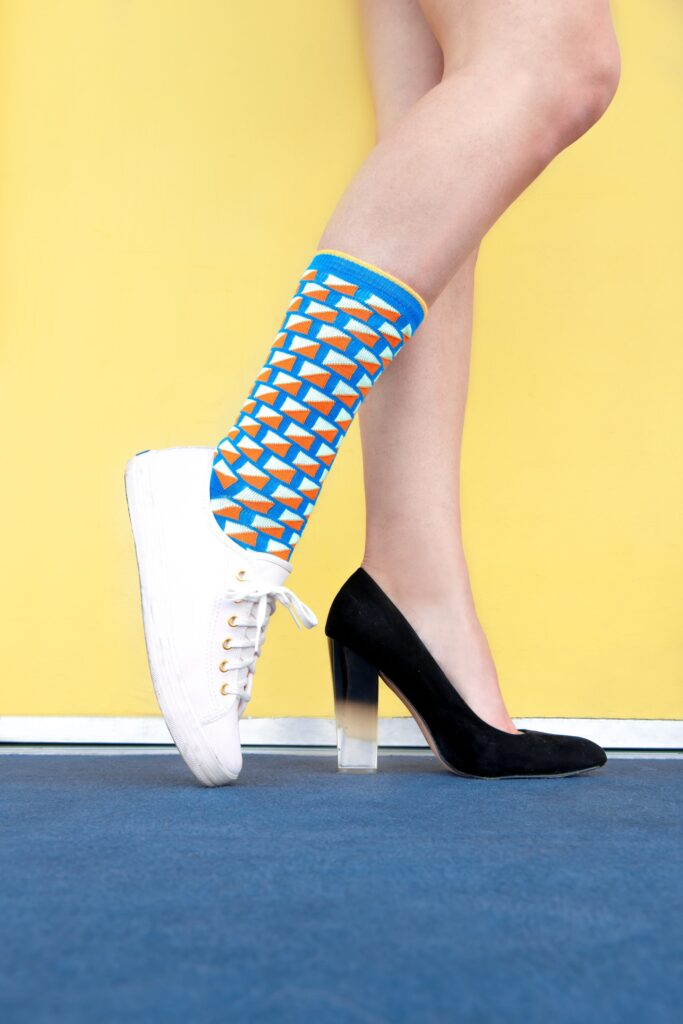It seems natural to want to know what heel height is appropriate for the office.
After all, who wants to make an embarrassing etiquette mistake at work? At worst it could be career-limiting.
Often people asking about heel heights also ask whether a particular kind of footwear is work-appropriate too. This could be heeled sandals, knee high boots or slingbacks – there are so many heel types that people are unsure will be accepted in the office.
Of course office life would be easier if we knew that a particular height of heel was work appropriate!
Shoes could simply be divided between “work” and “play” and that would be the end of it.
But although these questions sound simple the answers are not straightforward.
There’s a good reason why you will not find a definitive answer to questions about office-appropriate heel heights or shoe fashions on the internet or even in old fashioned etiquette guides.
Asking whether a particular heel height is too high or not high enough for work is a little like asking what sort of coat or jacket is appropriate to go outside the house in. It really depends on many things, including the conditions and what you are doing!
There are so many variables involved between office types, job types, communities, cultural standards and so on.
In fact there are almost as many differences between offices as there are types of heels seen in workplaces today!
What is appropriate in one setting may be hopeless in another.
So how do you decided if your heels are an appropriate height for work? I have set out some ways to do this below.
Your heel height needs to be totally practical

The key point can be shortly stated. If you can’t do your job in your heels, then they’re too high.
If you’ve ever seen a colleague come into the office with a new set of long acrylic nails and then realise that she can’t type with them, you know where I’m going with this.
Your heel height needs to be 100% practical.
For most women that means no higher that 4.5 inches (and usually lower than that) on a daily basis. Generally around the 3.5-4.5 inch mark is as high as work pumps need to go.
By all means, if you can wear higher heels then go for it. But most women can’t wear 5 inch heels every day, at least not without a platform. Even supermodels struggle to do that.
If your job involves some walking or long periods of standing then you need to think practical. Four inches, tops. And commute in flats for goodness sake.
What is everyone else wearing?
While you should not aim to dress like everyone else, a good guide to acceptable shoe-etiquette is to look at what others are wearing.
First of all, look at your own office but also consider the industry that you work in too.
Your location may also be relevant as some are more laidback and some are more old-fashioned (or fashion-forward) than others.
The truth is that there are many different office types: San Diego may be different from Wall Street, open plan may differ from closed door, a fashion startup will be different from an accountant.
I have heard of different New York law firms, sitting side by side. In one of them, every second female lawyer is wearing 4 inch Louboutin Pigalles. In the other one, everyone wears flats for comfort!
Importantly, in the second firm there is no “ban” on high heels and you could wear them if you wanted. It is just that there isn’t such an expectation. The first firm hasn’t made them compulsory either.
Hence, once you’ve had a look at what others are wearing in your office, don’t be afraid to step outside that provided that your heels are industry and location appropriate.
PS there’s no prohibition on wearing Christian Louboutin shoes in the office per se either. Which brings me to…
Are my heels too sexy for the office?
There’s one obvious problem with the question of whether heels are too sexy for the office. The fact is that many heels – particularly high heels – are meant to be sexy.
Of course sex appeal is not usually the reason we wear heels to work. We know they make us look great and feel more confident. But they are often sexy nonetheless.
And once we accept that heels are sexy, it becomes a bit of an unclear line in deciding how sexy is too sexy.
Once again here, heel height should be an important consideration. We can also rule out some obviously inappropriate shoes too, such as stripper shoes.
If your shoes don’t suit your corporate wardrobe, then they should be left for the weekend. Beyond that, choosing sexy shoes is really up to the wearer.
Here you should carefully consider the type of attention that you want to be attracting.
Some attention and compliments are great, but if your heels are distracting from your genius then you may wish to reconsider.
Are there shoe types that are inappropriate for the office?

This question once again depends on the office.
I have seen lots of offices where knee-high boots are totally fine (and they keep our legs warm too). However, some offices may frown on them.
Peep toe heels, high heel sandals and other open toed shoes are generally accepted too.
There seems no reason why these should not be worn provided you obey the golden rule: get a pedicure first!
Also, never wear flip flops in the office (yuck!). If you have beach footwear, save it for the beach.
Can I wear scratched / dirty / scruffy heels to the office?
Speaking of golden rules, the answer to this one is: no you can’t wear scruffy shoes in an office environment.
Whatever work pumps you choose, they will reflect the standards of your workplace and importantly, you.
If “professional footwear” means anything at all, it means being neatly and tidily turned out in the shoe department.
And that’s a rule I think we can all live with.

